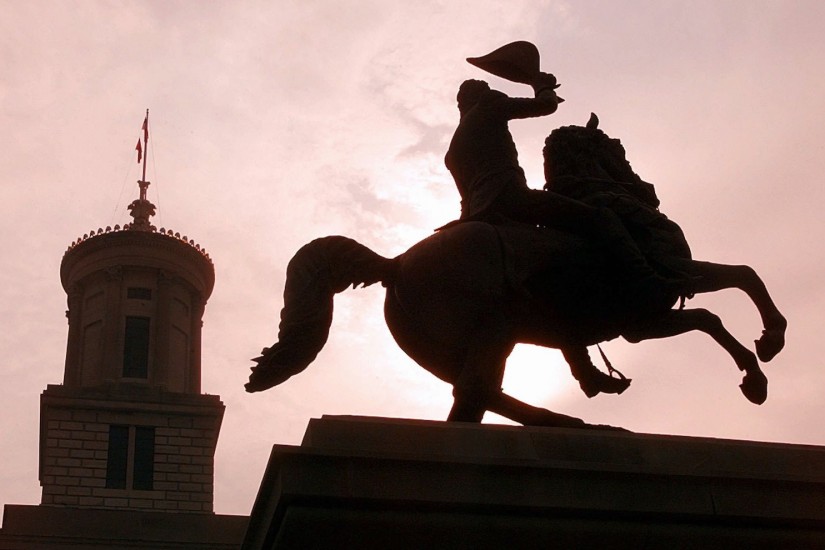It is no secret that Donald Trump admires President Andrew Jackson. At Trump’s direction, Jackson’s portrait now hangs in the Oval Office, a controversial choice given heightened public recognition of Jackson’s violent legacy.
But it is also an apt choice. By attacking four minority congresswomen, as well as defiantly announcing an executive action to get around the Supreme Court’s recent decision on the U.S. Census case, Trump is embracing the two components of Jackson’s presidency that make him most reviled: his mistreatment of minorities and his abuse of presidential power.
During his presidency, Jackson trampled the rights of Native Americans, pandered to white supremacy and violated congressional and legal restrictions on his executive power. Today, Trump is following in his footsteps, abusing executive power to assail some of society’s most vulnerable people. If the other branches of government won’t hold the president accountable, voters must — or the results could be deadly, as Jackson’s legacy reminds us.
Jackson has become notorious in U.S. history for his forced removal of Native Americans living in states on the East Coast to west of the Mississippi River. Most infamously, his actions led to the Trail of Tears that killed 4,000 Cherokee people.
The actions that led to the Trail of Tears were fueled by Jackson’s embrace of white supremacy. But they were also a direct violation of the law. Issued in March 1832, eight months before Jackson’s reelection in November, the Supreme Court ruled in Worcester v. Georgia that Cherokees had sovereignty over their homelands. The case provoked a firestorm. Its recognition of Native American rights was unprecedented.
It also stood in contrast to the passage of the Indian Removal Act that Jackson had forced through Congress in 1830. Supreme Court Chief Justice John Marshall understood that Jackson would oppose any decision protecting Native American rights, but issued the ruling anyway. Jackson responded by proclaiming the ruling to be “stillborn” and continued to enforce his violent policy of Native American removal, while the Supreme Court seemed powerless to intervene.
Both the issues of Native rights and presidential overreach dominated the 1832 election. In some states that were experiencing a rise in social activism, such as Massachusetts, voters expressed disgust at Jackson’s disrespect for both the rights of Native Americans and the rule of law as decided by the Supreme Court. Before the election, public meetings, including Native American speakers, were held in Boston to large crowds of people angry with the president. In October 1832, the Boston Courier explained that “Jackson will be the head of the Southern party, to advance its influence, and to cripple and retard the interests of a portion of the Eastern, Middle and Western States.” Jackson didn’t reflect the values of Massachusetts voters — but he won the election anyway.
His second term was filled with controversy. His policy of deadly Native American removal divided Congress; many opposed to the practice spoke out. Representatives of northern states that were gripped by religious revivalism highlighted the immorality of the policy. As white southerners gained more land, some northerners associated the removal policy with the spread of slavery in the South, which was becoming an increasingly fraught debate. Another argument framed the issue as a dangerous expansion of executive power.
But Jackson was undeterred, and the human costs were stunning, both in continued removal policy and in the ensuing Second Seminole War, which lasted from 1835 to 1842. When Jackson did face serious rebuke, it was for overstepping the boundaries of his office on an issue unrelated to his white supremacy. He became the first and only president to be reprimanded by a congressional censure, when he attempted to dismantle the federal bank by removing its funds and distributing them to chosen state banks while Congress was out of session. Ultimately, his censure was expunged when his party regained control of the Senate; even then partisanship won out over concerns about executive overreach.
Trump today is counting on it. He is playing a dangerous game of blending outright racism — suggesting that several members of Congress should “go back” where they came from — with executive overreach, promising to defy the spirit of the Supreme Court’s ruling against the administration in the census case. The Supreme Court stopped him from including a citizenship question on the decennial census. Where Jackson all but ignored the Supreme Court’s ruling against him in 1832, Trump issued an executive order demanding that the Commerce Department gain citizenship data through a variety of agencies, including Social Security and the Department of Homeland Security.
Trump is questioning citizenship, not only in the legal sense of the term, but in a broader conception of who counts and who belongs. Debates over citizenship have long been the cornerstone of nativism, xenophobia, and racism in the United States. And Trump is abusing presidential power — from the bully pulpit of his Twitter handle to the federal bureaucracy — to challenge the citizenship of his political opponents and of all of America’s residents.
Trump’s faith in the continued appeal of these racist attacks will soon be tested in the upcoming election. Like Jackson’s reelection in 1832, both minority rights and limits on executive power will be on the ballot in 2020. American voters will need to answer a question that has been the cause of much abuse, bloodshed and suffering in our history: Who belongs and who counts in America’s democracy?
